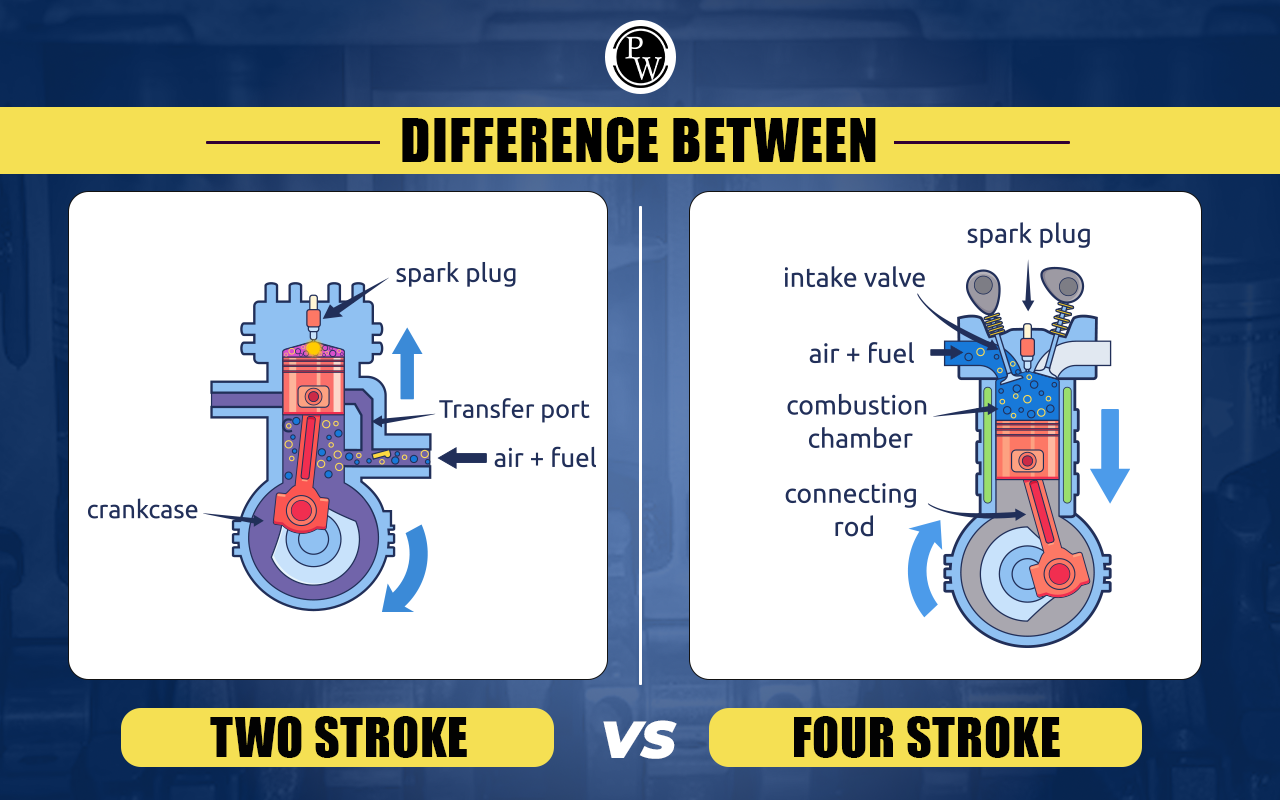Two-stroke engines complete a power cycle in only two piston strokes, while four-stroke engines require four strokes. The primary distinction lies in their operational efficiency and power generation process.
Knowledge of the differences between two-stroke and four-stroke engines is essential for automotive enthusiasts and professionals alike. These engines distinguish themselves not just by their process cycles, but also in their design, performance, fuel economy, and environmental impact.
Two-stroke engines are typically lighter and can produce twice the power of four-stroke engines of the same size because they fire once every revolution of the crankshaft.
Conversely, four-stroke engines are more fuel-efficient, produce less pollution, and offer smoother operation, which is why they’re commonly used in cars, motorcycles, and lawn equipment.
Each type has its own set of advantages that cater to specific applications, making the choice between them dependent on the desired balance between power output and long-term efficiency.
Table of Contents
Two-stroke Vs. Four-stroke Engines
Engines power our cars, motorcycles, and many tools. There are two main types: two-stroke and four-stroke. How do they work differently? Let’s dive into the mechanics and history behind these engines!

Credit: primesourceco.com
The Basic Mechanics Of Internal Combustion Engines
Every engine turns fuel into power. They do this through internal combustion. But the steps they use are different. Let’s look at what makes the two-stroke and four-stroke engines unique.
- Two-Stroke Engines: Complete a cycle in two movements of the piston.
- Four-Stroke Engines: Use four piston movements to complete a cycle.
| Two-Stroke Engine | Four-Stroke Engine | |
|---|---|---|
| Number of Cycles | 2 | 4 |
| Piston Movements | 1 up, 1 down | 2 up, 2 down |
| Power Strokes | Every cycle | Every other cycle |
Historical Development Of Engine Technology
The journey of engines began long ago. Steam engines were first. Then, internal combustion engines came. Here is how our engines evolved:
- Steam Engines: Used in the 18th century for trains and factories.
- Gas Engines: Appeared in the 19th century, leading to the first cars.
- Electric Engines: Developed alongside gas, but took longer to become popular.
Two-stroke and four-stroke engines came next. They powered different machines across the globe. The two-stroke was simple and light. The four-stroke was more complex but efficient. Both engines change the way we live and move.
Anatomy Of A Two-stroke Engine
The anatomy of a two-stroke engine holds the key to its unique abilities. With an operation as interesting as its design, the two-stroke engine is a marvel of engineering. Let’s dive under the hood and explore the specific components that allow it to function so distinctly.
Characteristic Components
Unlike their four-stroke counterparts, two-stroke engines have a simplified but clever setup that enables them to complete a power cycle in just two piston strokes. Here are the characteristic components that make this possible:
- Cylinder: Houses the piston’s movement.
- Piston: Moves up and down to power the engine.
- Spark Plug: Ignites the fuel mixture.
- Reed Valve: Controls fuel mixture entry.
- Exhaust Port: Where burnt gases exit.
- Transfer Ports: Passages for fresh fuel mix.
The Two-stroke Cycle Process
The two-stroke cycle process is fascinating. In two-strokes, the engine completes a combustion cycle with just two piston movements—down and up.
- Intake and Compression: As the piston moves up, the fuel mix enters. The reed valve then seals shut, and compression begins.
- Power and Exhaust: The spark plug fires at the top of the stroke, driving the piston down. As it nears bottom, exhaust gases exit.
- Scavenging: Fresh fuel is pushed into the cylinder as the piston exposes transfer ports, pushing out remaining exhaust.
This swift and efficient cycle allows the two-stroke engine to produce power more frequently than the four-stroke, leading to higher power-to-weight ratios.
Anatomy Of A Four-stroke Engine
The heart of many modern machines is the four-stroke engine. Efficiency and reliability set it apart from its two-stroke cousin. Let’s dive deeper and dissect the key components that make up this intricate marvel of engineering. Understanding these parts reveals how the engine breathes, compresses, combusts, and exhausts to power everything from cars to lawnmowers.
Key Components And Their Functions
Every four-stroke engine relies on key parts to operate. Below is a list of these components and their roles:
- Cylinder: Houses the piston’s movement and combustion process.
- Piston: Moves up and down to compress fuel and air.
- Spark Plug: Ignites the air-fuel mixture to start combustion.
- Valves: They open and close for fuel intake and exhaust release.
- Crankshaft: Converts the piston’s motion into rotational movement.
- Camshaft: Controls the timing of valve openings.
These components work in perfect harmony. Their precise coordination results in the engine’s smooth operation.
The Four-stroke Cycle Explained
The cycle of a four-stroke engine includes four vital stages:
- Intake: The valve opens; air and fuel enter the cylinder.
- Compression: The valve closes; the piston compresses the mixture.
- Combustion: The spark plug fires; the mixture ignites and pushes the piston down.
- Exhaust: The exhaust valve opens; gases exit the cylinder.
This process repeats. It turns fuel into movement. The engine’s design ensures each step occurs at the right time. This maximizes power and efficiency.

Credit: www.quora.com
Comparing Power Delivery And Efficiency
When choosing an engine for a motorcycle or other small machinery, understanding how two-stroke and four-stroke engines deliver power and use fuel helps make an informed decision. This section details the differences in power output and fuel efficiency between these engine types.
Power Output Differences
The way two-stroke and four-stroke engines generate power varies significantly. A key point to remember is:
- Two-stroke engines fire once every revolution, which means they provide high power for their weight. This leads to a faster response when accelerating.
- Four-stroke engines, on the other hand, fire once every other revolution. They deliver power more smoothly, which can translate to better stability and longer engine life.
For a quick comparison:
| Engine Type | Power Delivery |
|---|---|
| Two-stroke | Higher power-to-weight ratio, rapid acceleration |
| Four-stroke | Consistent and smoother power, enhanced control |
Fuel Efficiency And Consumption
Fuel efficiency is another key factor that differentiates two-stroke and four-stroke engines:
- Two-stroke engines tend to consume more fuel as they mix oil and fuel, resulting in less efficient combustion.
- Four-stroke engines have separate compartments for oil and fuel, resulting in better fuel efficiency and less oil consumption.
Consider efficiency:
- Two-stroke engines burn more fuel and oil.
- Four-stroke engines use fuel more efficiently, saving costs over time.
Environmental Impact And Emissions
Two-stroke and four-stroke engines differ not just in mechanics but also in their environmental footprint.
Pollutant Emission Profiles
Two-stroke and four-stroke engines have different emission profiles. Two-stroke engines release more pollutants due to their oil and fuel mix. They burn this mix, causing higher emissions of hydrocarbons (HC) and particulate matter. Four-stroke engines have separate compartments for oil and fuel, which leads to cleaner combustion. As a result, they emit fewer pollutants compared to two-stroke engines.
Advancements In Emission Reduction
Manufacturers have made strides in reducing emissions for both engine types.
- Direct Injection Technology: Used in two-strokes to reduce HC emissions.
- Catalytic Converters: Common in four-strokes, they limit CO and NOx emissions.
- Fuel Management Systems: Improve efficiency and reduce emissions in both.
These technologies ensure both two-stroke and four-stroke engines are more eco-friendly.
| Engine Type | CO | HC | NOx | Particulates |
|---|---|---|---|---|
| Two-Stroke | High | Very High | Medium | Medium |
| Four-Stroke | Lower | Low | Reduced with Catalytic Converter | Low |
With ongoing research, we can expect even lower emission levels in the future.

Credit: byjus.com
Maintenance And Durability
Two-stroke and four-stroke engines differ not just in operation, but also in how they are maintained and how long they last. Understanding these differences is essential for anyone who owns or plans to buy a motor vehicle or a piece of equipment that uses these engines.
The typical lifespan of an engine depends largely on its type. Each has its benefits and drawbacks.
| Engine Type | Average Lifespan |
|---|---|
| Two-Stroke | Shorter due to increased wear |
| Four-Stroke | Longer with less frequent use |
Generous lubrication and simpler construction of two-strokes lead to more wear and tear. In comparison, four-strokes usually have a more robust design, resulting in a longer engine life.
Regular maintenance keeps engines running smoothly. The type dictates the maintenance workload.
- Two-Stroke Engines:
- Need frequent oil changes.
- Gas and oil mix is required.
- Simpler design can mean easier, yet more frequent, fixes.
- Four-Stroke Engines:
- Oil resides in the crankcase and needs periodic changing.
- Have separate compartments for fuel and lubricants.
- Typically, they need fewer repairs but are more complex.
Overall, two-strokes require more constant attention but are generally easier to work on. Four-strokes, with their intricate systems, need service less often but demand more expertise when they do.
Typical Applications And Use Cases
Selecting the right engine for the job means looking at their common uses.
Common Two-stroke Engine Applications
Two-stroke engines are popular in several machines. The reasons are their simplicity and high power-to-weight ratio. Lightweight and less complex, they roar in:
- Lawn equipment: Grass trimmers and leaf blowers often use two-stroke engines for their compact size.
- Mopeds and small motorcycles: They benefit from the quick power delivery of two-strokes.
- Marine applications: Outboard motors and jet skis enjoy high power for rapid acceleration.
- Recreational vehicles: Snowmobiles and dirt bikes need strong bursts of power, ideal for two-stroke designs.
Where Four-stroke Engines Dominate
Four-stroke engines rule in areas requiring efficiency and durability. They shine in:
- Automobiles: Cars and trucks demand the steady and efficient power delivery from four-strokes.
- Commercial equipment: Generators and pumps often rely on four-stroke engines for continuous operation.
- Large motorcycles: They offer better fuel economy and reduced emissions, key for longer rides.
- Agriculture: Tractors and combines use four-stroke engines for efficient power throughout long work periods.
The Future Of Engine Design
The Future of Engine Design promises to reshape our understanding of powertrains. With the need for efficiency and eco-friendliness, traditional engines are evolving. Two-stroke and four-stroke engines have paved the way for advancements that we’ll explore next.
Emerging Technologies In Engine Design
New engine technologies are often born from the quest for sustainability and performance. Here’s a glimpse into the pioneering tech changing the game:
- Variable Compression Ratio Engines adjust to optimize power and fuel economy on the fly.
- Direct Injection Systems enhance fuel efficiency by delivering precise fuel amounts.
- FreeValve Technology eliminates the camshaft for improved control and performance.
- Electric-hybrid Systems pair traditional engines with electric motors to boost efficiency.
The Shift Towards Alternative Energy Sources
As we adapt to environmental challenges, alternative energy engines take center stage:
- Electric Engines rely on batteries and offer silent, green power without combustion.
- Hydrogen Fuel Cells combine hydrogen and oxygen to create power and emit only water.
- Solar-Powered Engines harness the sun to propel vehicles, perfect for small applications.
Transition to these energy sources means cleaner, more sustainable mobility ahead.
FAQ
What Is The Difference Between A 2 Cycle And 4 Cycle Engine?
A 2-cycle engine completes its power cycle in one crankshaft revolution with two strokes, mixing fuel and oil, while a 4-cycle engine takes two revolutions with four strokes, separating oil and fuel, resulting in higher efficiency.
What Is The Difference Between A Two-stroke And A Four-stroke Engine Quizlet?
A two-stroke engine completes its power cycle in two piston movements; intake and exhaust occur simultaneously. A four-stroke engine requires four movements, separately handling intake, compression, combustion, and exhaust phases.
What Is The Difference Between 2-stroke And 4-stroke Power Output?
A 2-stroke engine delivers power every two piston strokes, while a 4-stroke engine produces power every four strokes, resulting in smoother operation and better fuel efficiency.
What’s The Difference Between 2-stroke And 4-stroke Oil?
Two-stroke oil blends with fuel and offers lubrication as it burns, while four-stroke oil lubricates within the engine’s crankcase without mixing with fuel.
Bottom Line
Having knowledge of engine types is crucial for any motor enthusiast or prospective buyer. We’ve explored the differences of two-stroke and four-stroke engines, highlighting their unique characteristics, fuel efficiency, and performance dynamics. Remember, your choice depends on your specific needs and preferences.
Picking the right engine can enhance your machinery’s performance and longevity, ensuring a wise investment for your mechanical ventures.




Leave a Reply